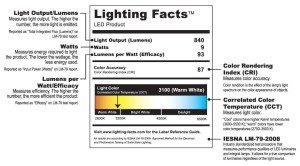Energy Efficient Lighting
The Quality Advocates’ Lighting Facts label verifies reported performance claims for LED replacement lamps and luminaires.
By Craig DiLouie, LC
What you need to know:
- LED lighting can provide benefits such as high efficiency and long service life
- As a relatively new technology, it can be difficult to choose good products
- The Lighting Facts label provides an at-a-glance view of key performance attributes
- The label reveals light output, wattage, efficacy, color temperature and color rendering
 The Quality Advocates Initiative Lighting Facts Label provides important information about LED lighting products. Image: US Department of Energy
The Quality Advocates Initiative Lighting Facts Label provides important information about LED lighting products. Image: US Department of EnergyThe light-emitting diode (LED) has been around for a long time, but LED lighting is still a relatively young technology. While LED replacement lamps (light bulbs) and luminaires (light fixtures) can provide great benefits such as energy efficiency and long service life, consumers should be cautious about selecting the right product.
A Label for LEDs
The Lighting Facts label for solid-state lighting products, developed by the Quality Advocates Initiative—a partnership between the U.S. Department of Energy and the lighting industry—provides a valuable tool that can help consumers evaluate and compare LED lighting products. Unlike the Federal Trade Commission’s mandatory Lighting Facts label for medium screw-base lamps, the Quality Advocates’ Lighting Facts label is voluntary, applies to LED replacement lamps and luminaires, and is oriented to retailers, utilities and lighting professionals (even though consumers are certainly welcome to use it, and would benefit in doing so). The FTC does not verify reported performance claims, while the Quality Advocates Initiative does.
Product manufacturers that participate in the Quality Advocates Initiative sign a pledge to follow certain guidelines and report performance claims for their products. First, each product is tested according to the IES LM-79 standard, providing assurance that each product is tested in the same basic way. The test data is verified as part of product registration, and then the product can carry the Lighting Facts label.
What It Does
The Quality Advocates Initiative label provides summary performance data in a simple format similar to the Nutrition Facts label on food products. It includes light output (lumens), wattage, efficacy (lumens per watt), correlated color temperature and color rendering index (CRI) rating. The higher the lumens, the more light the product produces. The higher the efficacy, the more light it produces per unit of electrical power.
The color metrics cover color appearance and color rendering ability. Color temperature describes the color appearance of a light source and its light emission. Light sources are generally classified as “cool,” or bluish-white (greater than 4,000K); “neutral,” or white (3,000K–4,000K); or “warm,” which appear orangish-white (less than 3,000K). The CRI rating expresses how the light affects an object’s color appearance. For many applications the higher the CRI the better, with 80-100 CRI being the optimal range.
Wattage is just one part of the story of a lighting product along with how much light it produces and the color quality of that light. Even so, the Lighting Facts label does not tell the whole story. For example, it does not cover service life, whether the lamp can be dimmed and whether it is suitable for indoor or outdoor use.
Learn more about these lighting facts.